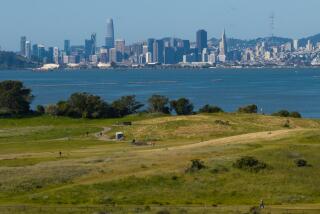Calleguas Water Plant to Open a Year Late : Services: The district faces a state deadline to get the treatment facility running. But no penalties are expected.
The Calleguas Municipal Water District, which had dragged its feet before starting construction of a state-mandated filtration plant at Bard Reservoir, lost another two months of construction time due to recent storms and now expects to open the $35-million plant one year past a state deadline, officials said.
The plant is now scheduled to open in June, 1994, said Don Kendall, the district’s general manager.
“Come June of 1993, we will not be in compliance,” Kendall said. “We’re trying to do the prudent thing, but we don’t like to have that deadline hanging over us.”
But a California Department of Health Services official said the state won’t impose sanctions as long as Calleguas is moving ahead with construction.
“If we had a system that’s not doing anything or snubbing their nose at us, we’d have to take some legal action,” said John Curphey, the department’s district sanitary engineer. But “there are a lot of systems that aren’t going to meet the deadline.”
Calleguas at first resisted building the plant, arguing it was unneeded because the water in the reservoir is already treated by the Metropolitan Water District of Southern California, from which Calleguas buys all its water. Calleguas, Ventura County’s largest water wholesaler, resells the water to several public and private water companies.
The district has chlorinated the water at Bard Reservoir for years with no apparent health problems.
But state officials said Calleguas had no choice but to build the plant. The regulations require agencies that operate open reservoirs to filter impurities that may contaminate them.
The winter storms interrupted grading of the plant site, Kendall said. He said construction of the plant should begin in April.
The reservoir, which sits between Simi Valley and Thousand Oaks, was built in 1965 and holds 3.4 billion gallons of water.
Meanwhile, a buildup of sediments in the water from storm-related runoff and winds led officials to shut the Bard Reservoir down for more than five days, said David Bustamante, an operations supervisor for Calleguas.
He said the higher level of sediments did not violate health standards and did not affect Calleguas’ ability to deliver water during the current period of low water usage.
Calleguas officials said releasing the water would have caused quality problems for some water companies that blend Calleguas water with ground water that typically is high in sediments.
Those users depend on the cleaner Calleguas water to raise the quality of the blended water, Kendall said. By releasing water with the higher sediment level, Kendall said, the water quality of some of those companies would have suffered.
Kendall said the new filtration plant will remove sediments and would have prevented the shutdown of the reservoir if it had been in operation.
Officials said water quality regulations at Bard Reservoir are so strict that not even Hollywood is exempt. The reservoir was recently used as a setting for the Robin Williams movie “Toys.” In one scene, a character runs to the end of a dock and falls into the lake. But the climax of the scene could not be filmed there because a longstanding Calleguas policy forbids any human contact with the water of Bard Reservoir.
BACKGROUND
The Calleguas Municipal Water District is required to build the filtration plant by the state Surface Water Treatment Rule of 1989. The rule applies to open reservoirs that are exposed to runoff carrying animal wastes and debris. Dirty water can carry parasites such as Giardia, a microscopic protozoan that can cause diarrhea.
More to Read
Sign up for Essential California
The most important California stories and recommendations in your inbox every morning.
You may occasionally receive promotional content from the Los Angeles Times.










